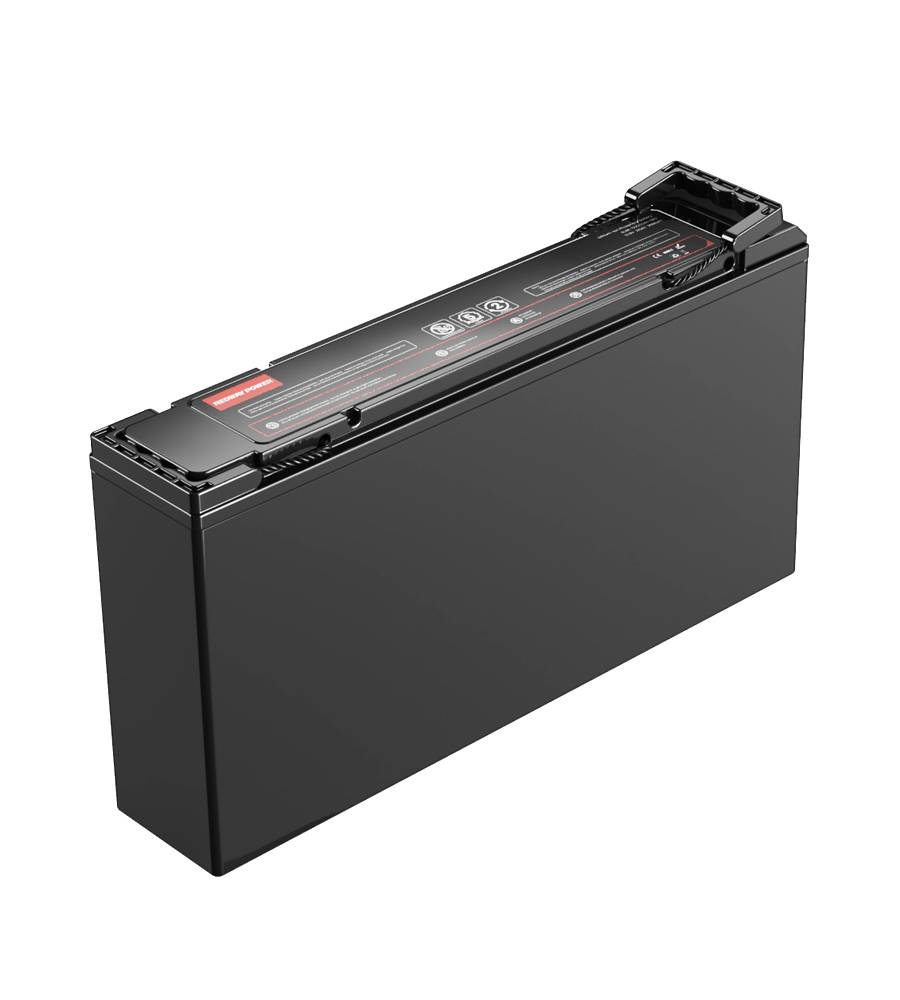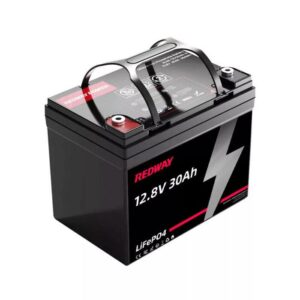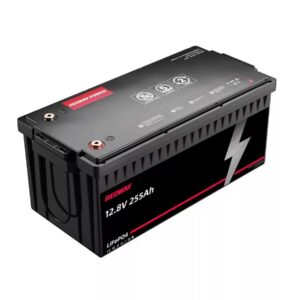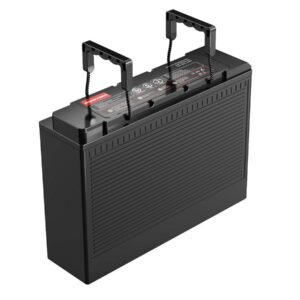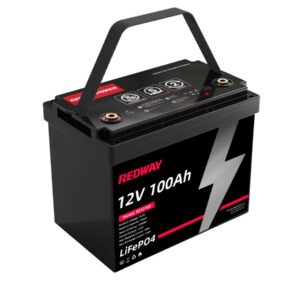Description
This 12.8V 150Ah LiFePO4 battery offers a high-performance energy storage solution with a nominal energy of 1920Wh. It features a nominal voltage of 12.8V and a nominal capacity of 150Ah, making it suitable for applications like solar power systems, electric vehicles, and backup power. The battery supports a maximum continuous charge and discharge current of 100A, with a max charge voltage of 14.6V and a discharge cut-off voltage of 10V. Its cycle life exceeds 4000 cycles at 80% depth of discharge, ensuring long-term reliability.
The battery is designed with robust physical and environmental specifications. It measures 552 x 110 x 288 mm (21.7 x 4.3 x 11.4 inches) and weighs 12.8 kg (28 lbs), making it compact and lightweight compared to traditional lead-acid batteries. It has an IP65 rating, providing protection against dust and water ingress, and operates efficiently in a wide temperature range: charge temperature from 0°C to 60°C and discharge temperature from -20°C to 65°C. The internal configuration is 4S10P with a low internal resistance of ≤20mΩ for efficient performance.
Additional features include a smart BMS (Battery Management System) for protection against overcharge, over-discharge, over-current, and temperature extremes. Optional upgrades such as Bluetooth, self-heating, LCD display, RS485, RS232, CAN, 4G/5G, GPS, and APP connectivity are available for enhanced monitoring and control. The battery shell is made of durable ABS material, and it comes with a 3-year warranty. Certifications include UL 1642, IEC 62619, UN38.3, and MSDS, ensuring compliance with safety and transportation standards.
What Makes a 12V 150Ah Cylindrical LiFePO4 Battery Durable and Efficient?
A 12V 150Ah Cylindrical LiFePO4 battery combines lithium iron phosphate chemistry with a robust cylindrical cell design, offering superior cycle life, thermal stability, and safety. Its high energy density and efficient charge-discharge cycles make it ideal for long-term, reliable power storage in various applications.
What is a LiFePO4 Battery and How Does It Work?
A LiFePO4 (lithium iron phosphate) battery is a type of rechargeable lithium-ion battery that uses iron phosphate as the cathode material. It operates by shuttling lithium ions between the cathode and anode during charge and discharge cycles, providing stable voltage and high current output. The chemistry offers excellent thermal stability and a longer lifespan compared to other lithium-ion batteries, making it safer and more durable for energy storage.
How Does Cylindrical Cell Design Impact Battery Performance?
Cylindrical cells are shaped like tubes, allowing for efficient heat dissipation and mechanical strength. This design enhances durability by reducing the risk of swelling and damage under stress. Cylindrical LiFePO4 cells also facilitate uniform current distribution, improving charge efficiency and cycle life. Their modular nature allows easy assembly into battery packs with consistent performance.
What Are the Advantages of a 12V 150Ah Cylindrical LiFePO4 Battery?
The key advantages include:
-
High energy density for compact, lightweight power storage
-
Long cycle life, often exceeding 2000 cycles at 80% depth of discharge
-
Superior thermal and chemical stability, reducing fire risk
-
Low self-discharge rate, maintaining charge over extended periods
-
Environmentally friendly materials with no heavy metals
These benefits translate into durable, efficient batteries ideal for renewable energy, electric vehicles, and backup power systems.
How Durable and Reliable Are These Batteries in Real-World Use?
12V 150Ah Cylindrical LiFePO4 batteries demonstrate exceptional durability due to their robust chemistry and construction. They resist capacity degradation under frequent charge-discharge cycles and tolerate wide temperature ranges without performance loss. Their cylindrical form factor adds mechanical resilience, making them suitable for harsh environments and demanding applications.
What Applications Benefit Most from 12V 150Ah LiFePO4 Batteries?
These batteries are widely used in:
-
Solar energy storage systems
-
Electric vehicles and e-bikes
-
Marine and RV power systems
-
Uninterruptible power supplies (UPS)
-
Portable power tools and equipment
Their combination of high capacity, safety, and longevity makes them versatile across residential, commercial, and industrial sectors.
How Does the Battery Management System (BMS) Enhance Safety and Efficiency?
A BMS monitors battery parameters such as voltage, current, temperature, and state of charge to prevent overcharging, deep discharge, and overheating. It balances cells to optimize performance and prolong lifespan. In 12V 150Ah cylindrical LiFePO4 batteries, the BMS is critical for ensuring safe operation and maximizing energy efficiency.
How Should You Maintain and Care for LiFePO4 Batteries?
Proper maintenance includes:
-
Avoiding deep discharge below recommended limits
-
Keeping batteries within optimal temperature ranges (typically 0–45°C)
-
Storing batteries at partial charge if unused for long periods
-
Regularly checking connections and cleaning terminals
These practices help preserve battery health and extend operational life.
How Does Temperature Affect the Efficiency and Lifespan of LiFePO4 Batteries?
Temperature significantly impacts battery performance. High temperatures accelerate chemical reactions, potentially causing capacity loss and safety risks, while low temperatures reduce available capacity and increase internal resistance. LiFePO4 batteries are more tolerant to temperature extremes than other lithium chemistries but still perform best within moderate temperature ranges.
How Does LiFePO4 Compare to Other Lithium Battery Chemistries?
Compared to lithium cobalt oxide (LCO) or nickel manganese cobalt (NMC) batteries, LiFePO4 offers:
-
Better thermal stability and safety
-
Longer cycle life
-
Lower energy density but higher power output
-
More environmentally benign materials
This makes LiFePO4 preferable for applications prioritizing safety and durability over maximum energy density.
Chart: Comparison of LiFePO4 vs. Other Lithium Battery Chemistries
| Feature | LiFePO4 | LCO | NMC |
|---|---|---|---|
| Cycle Life | 2000+ cycles | 500-1000 cycles | 1000-1500 cycles |
| Thermal Stability | High | Medium | Medium |
| Energy Density | Moderate (90-120 Wh/kg) | High (150-200 Wh/kg) | High (150-200 Wh/kg) |
| Safety | Excellent | Moderate | Moderate |
| Environmental Impact | Low | Higher | Moderate |
Chart: Typical Applications of 12V 150Ah Cylindrical LiFePO4 Batteries
| Application | Suitability | Key Benefit |
|---|---|---|
| Solar Energy Storage | High | Long cycle life |
| Electric Vehicles | High | High power output |
| Marine & RV | High | Durability |
| UPS Systems | Medium | Safety |
| Portable Tools | Medium | Lightweight |

